Finally, we can again see a comet with our naked eyes!
And it’s not just a faint spot on the sky, but a bright celestial object with a proper tail!
The new comet, officially called C/2020 F3 (NEOWISE), or often abbreviated as NEOWISE can be seen from the northern hemisphere in both the evening and dawn around the northern horizon.
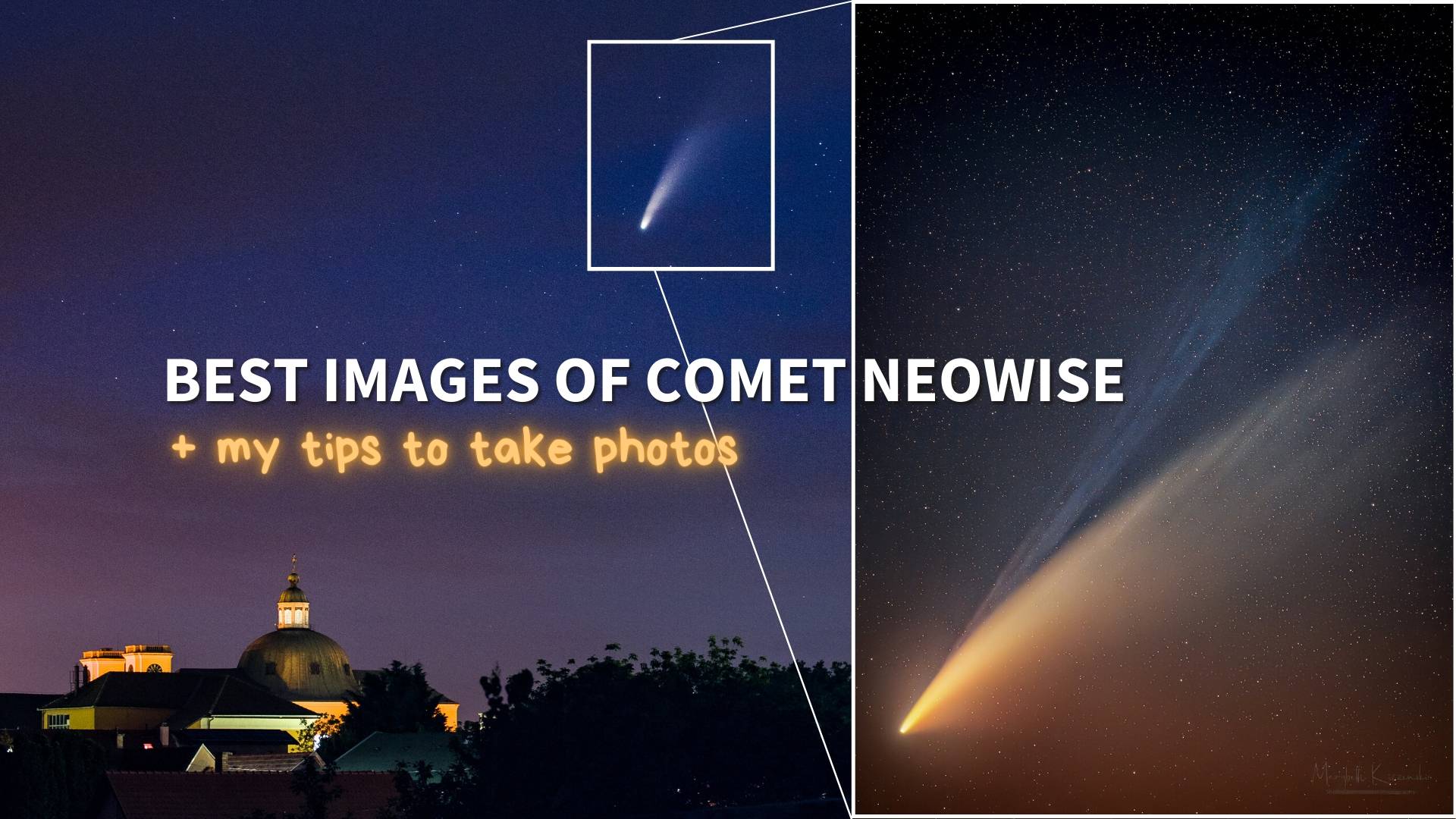
In this article I will:
- help you where to find the comet
- how to photograph it
- write about interesting science of comets
- collect the best photos of the NEOWISE from around the world (many people post their photos on Facebook, and I don’t want them to disappear in FB’s junk)
I took my first photo of the NEOWISE on the dawn of 10th July.
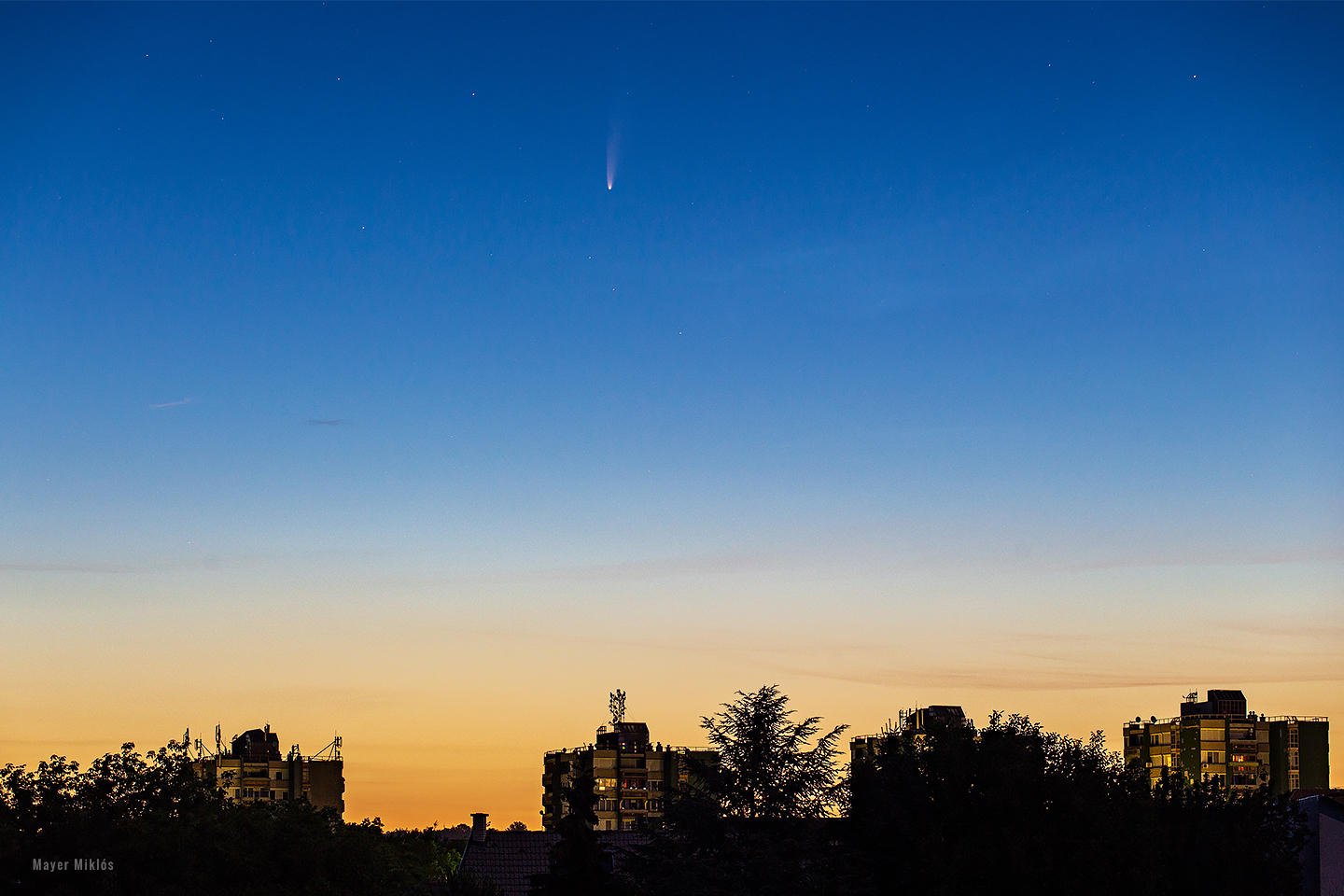
I have to admit, I didn’t get up early enough, and I got late by 30 minutes, so the sky was brighter than ideal. But still, comet NEOWISE could be easily seen.
I went out the next dawn too, but this time clouds were covering some parts – too bad!
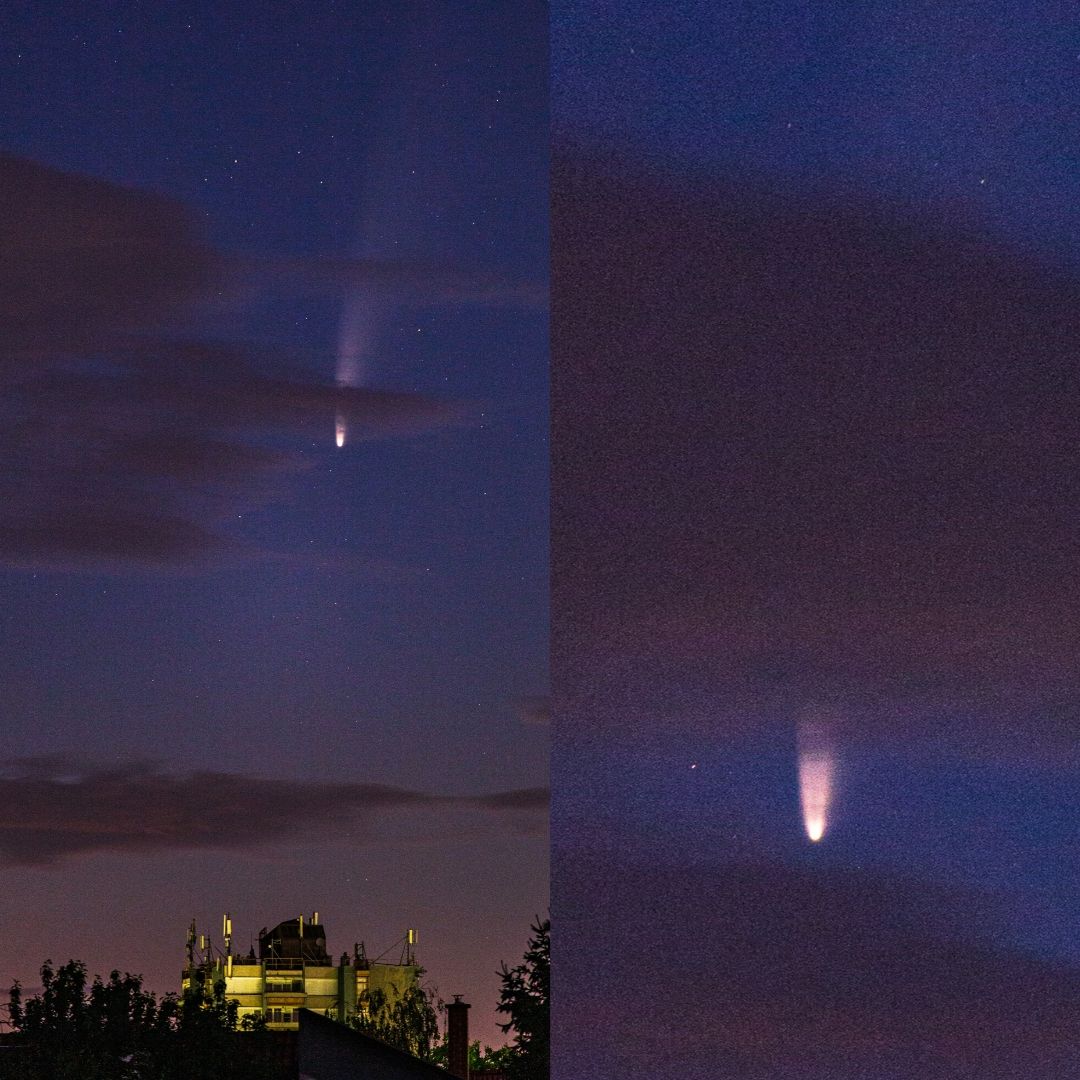
Even with the clouds, you can see how long its dusttail is (more on comet tails later in the article)
Where and when can you see the C/2020 F3 (NEOWISE) comet?
First of all, it’s only visible on the northern hemisphere – sorry Australia!
As of July 14th, it’s declination is +46 degrees, meaning the comet is circumpolar for all Canada, and the very northern part of the US, and for most of Europe.
(Circumpolar means that it’s close enough to the pole that it does not set under the horizon).
All this means that our best chance to see the comet is 1.5 – 2 hours after sunset, and if you’re north enough (+45 degree or norther), you can see it all night till dawn!
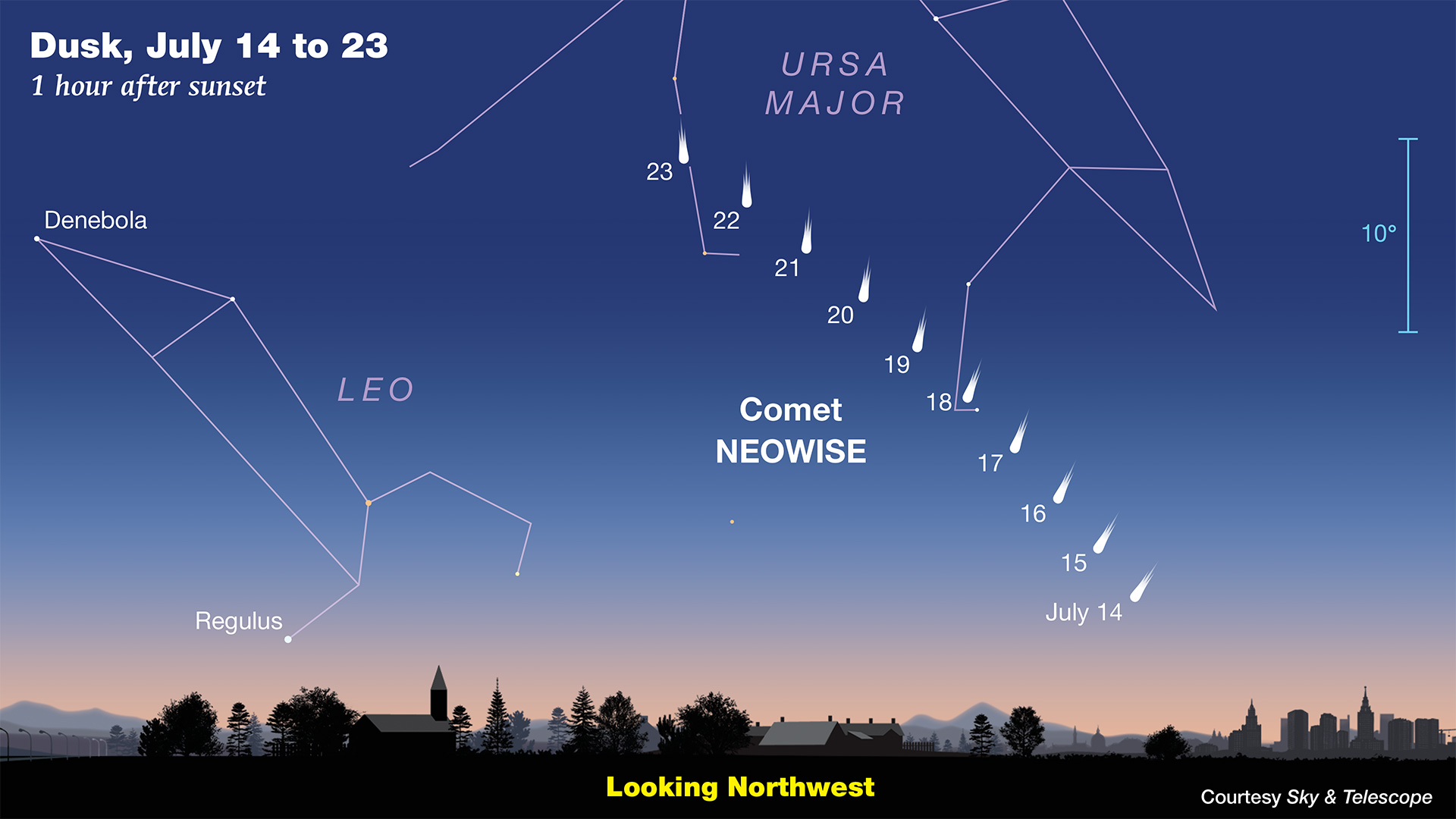

On 18th July, it’s declination will be the highest, with +48 degrees.
How bright is the C/2020 F3 (NEOWISE) comet?
As of writing the article on 14th July, I can say it’s super bright, and very easily findable – even in cities.
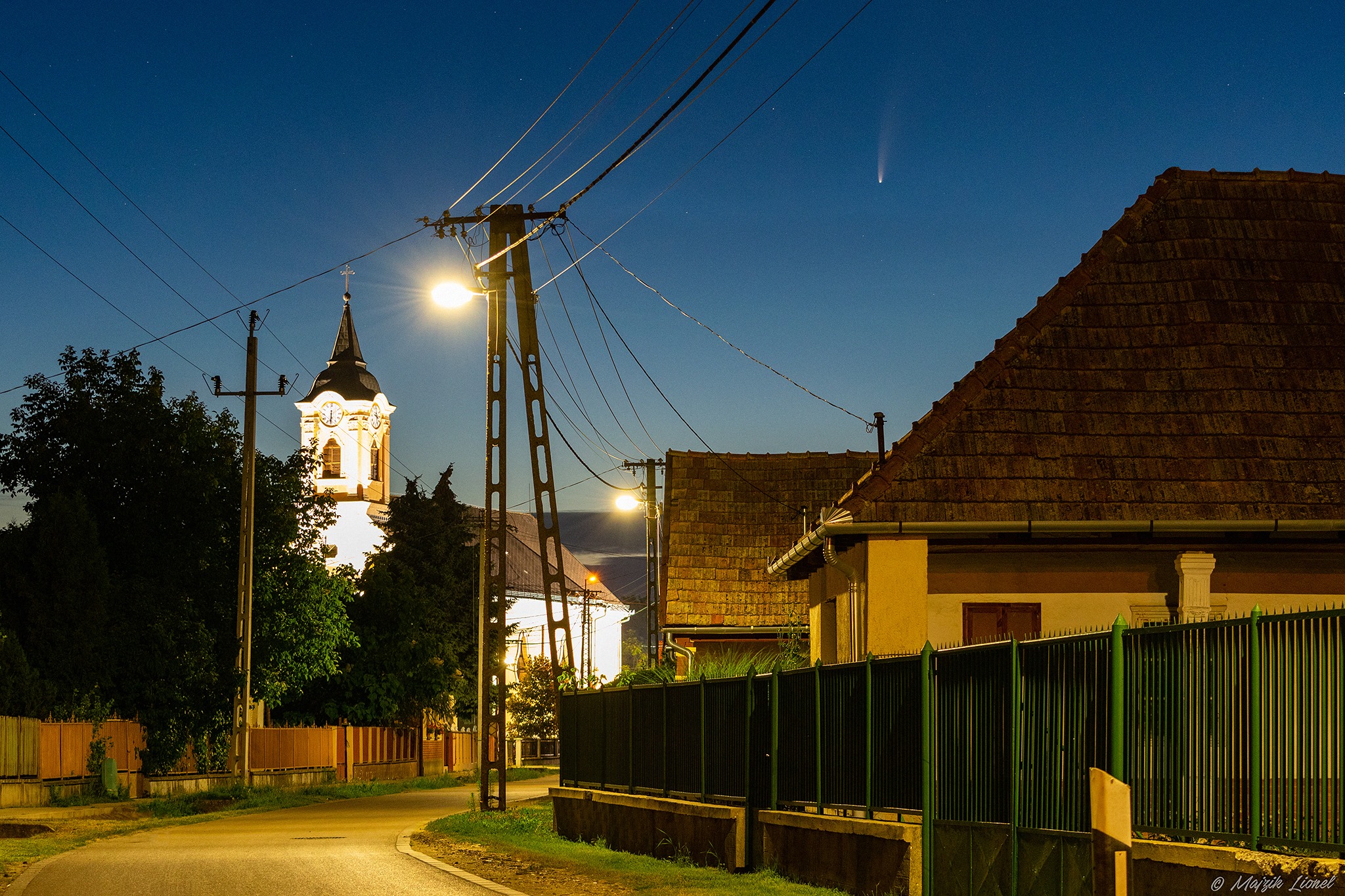
The comet NEOWISE got closest to the Sun on 3rd July (it was within the orbit of Mercury), after that it’s quickly distancing from the Sun.
But, luckily for us, it is also coming closer to the Earth, so it’s apparent brightness will not drop that much.
It’s very hard to measure (let alone predict) the brightness of comets, but most of the observers could see it as bright as +1 magnitude bright around 8-10 th July, fainting towards +2 magnitude to 14th July.
(Magnitude is what astronomers measure brightness with. The lower the number, the brighter it is. The stars of the Big Dipper are around +2 m, and the human eye can see stars down to +6 m on a clear night)
This means that it’s still very bright, and easily recognizable because of its ~10 degree long tail.
?: Comet NEOWISE over Manhattan, New York. From Yuri Beletsky, twanight.org/Beletsky : This is a collaborative project…
Közzétette: The World at Night – TWAN – 2020. július 11., szombat
Of course, you need to get a super clear sky to see the tail in its full length, but even on polluted skies, you can make it out to a few degrees.
(To give you scale, the Full Moon is 0.5 degree in diameter).
What’s sure is that C/2020 F3 (NEOWISE) comet will gradually be fainter and fainter, and by the end of July it will be considerably fainter.
It will be closest to Earth on 23rd July, at a mere 0.69 Astronomical Unit (~64,139,507 miles), but this time it will be pretty far from the Sun.
How to take photos of comet NEOWISE?
From a photograhy point of view, the comet NEOWISE should be treated like a bright star or any celestial object.
The very same rules apply photographing the comet, as with photographing the night sky / Milky Way.
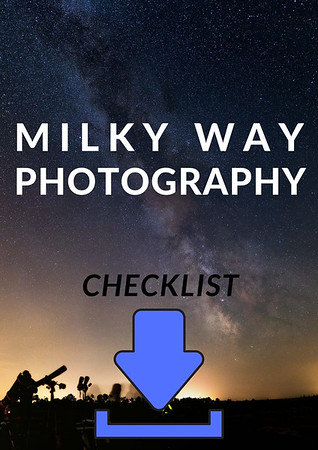
There are quite many things to pay attention to when setting up the camera for night photography.
That’s why I created an actionable checklist PDF, that you can download freely and take it with you under the sky to help.
Of course, you need a tripod, and it’s best to use Manual mode, setting a fast aperture (like f/2.8 or f/4).
The key is not to have too long shutter speed, otherwise the comet and the stars will leave trails, and will not be pinpoint-like (see further down an example).
I recommend using my astrophotography shutter speed calculator to determine the longest shutter speed you can use (more info about how the calculator works):
As the declination of NEOWISE is around +45 degrees, this practically means you can use the traditional 500 / focal length rule, and have sharp photos.
This will give you good results when viewing the whole photo on a smaller screen, but will not be good if you start pixel-peeping:
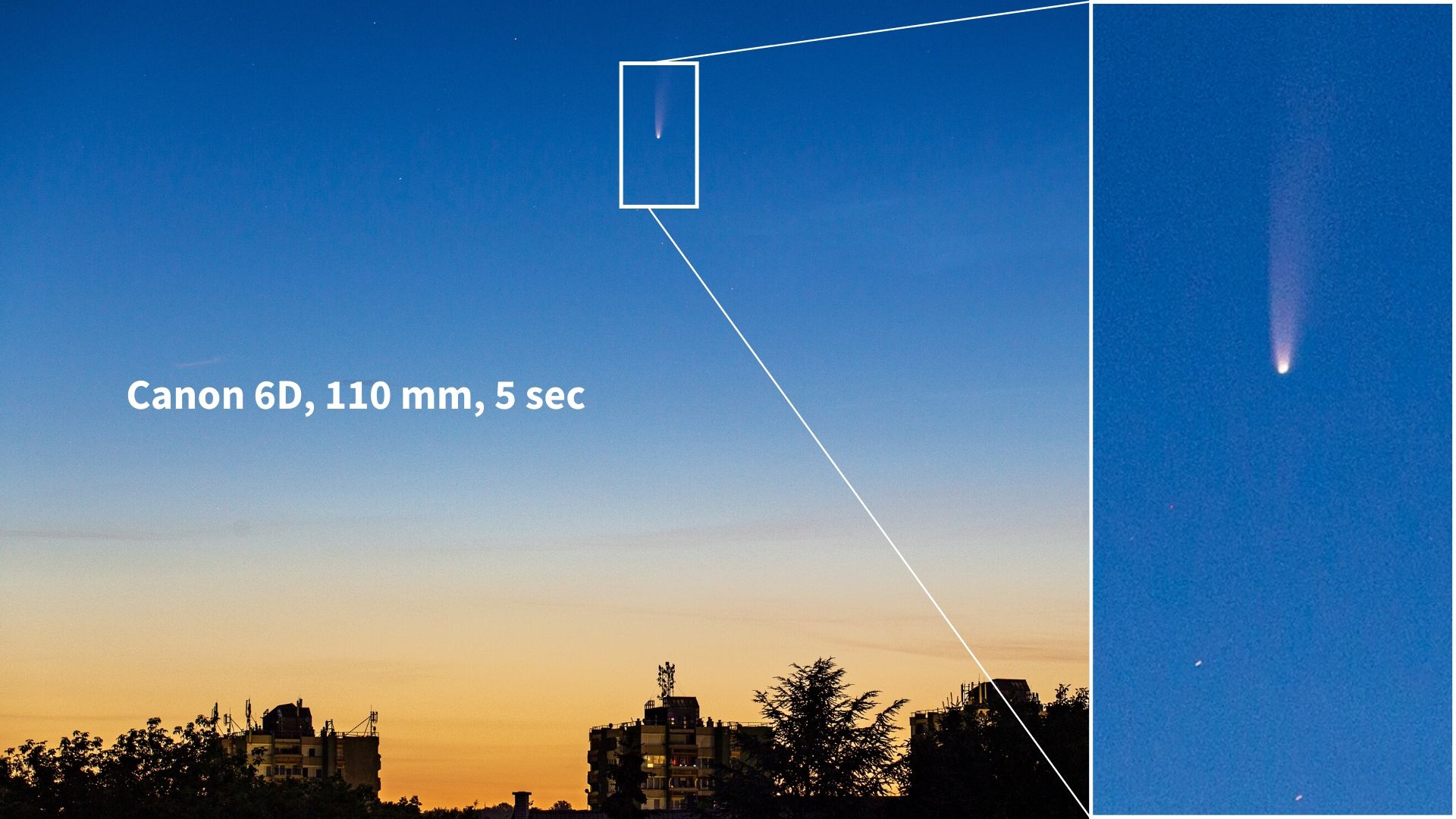
So if you want really sharp stars, even when magnified into the photos, then you should use 400 / focal length rule.
So for example:
With a full-frame camera + 100 mm lens, you can take 4 second,
with an APS-C sensor camera + 100 mm lens, you can take a 2.5 second long exposure.
Simply divide / multiply these values with the focal length you’re using.
Once you have a good composition, I recommend taking a series of shots right after each other (at least 7).
This is easiest if you put the camera’s drive mode into Continuous, and then you lock the exposure button on your remote release cable.
If you don’t have a remote release, then you can use the Self-timer continuous mode: in this mode, the camera can take up to 9 shots after a given time (almost every camera has this option, except for higher end Canons :)).
Then, later in editing, you can stack these almost-the-same photos to reduce noise both on the stars and on the terrain.
Softwares like Sequator and Starry Landscape Stacker can selectively stack sky and the foreground – I’ve used Sequator with excellent results.
Collection of best photos of C/2020 F3 (NEOWISE) comet from around the world
As always, click on any photo to view in larger size. All photos published with written consent of their creators.
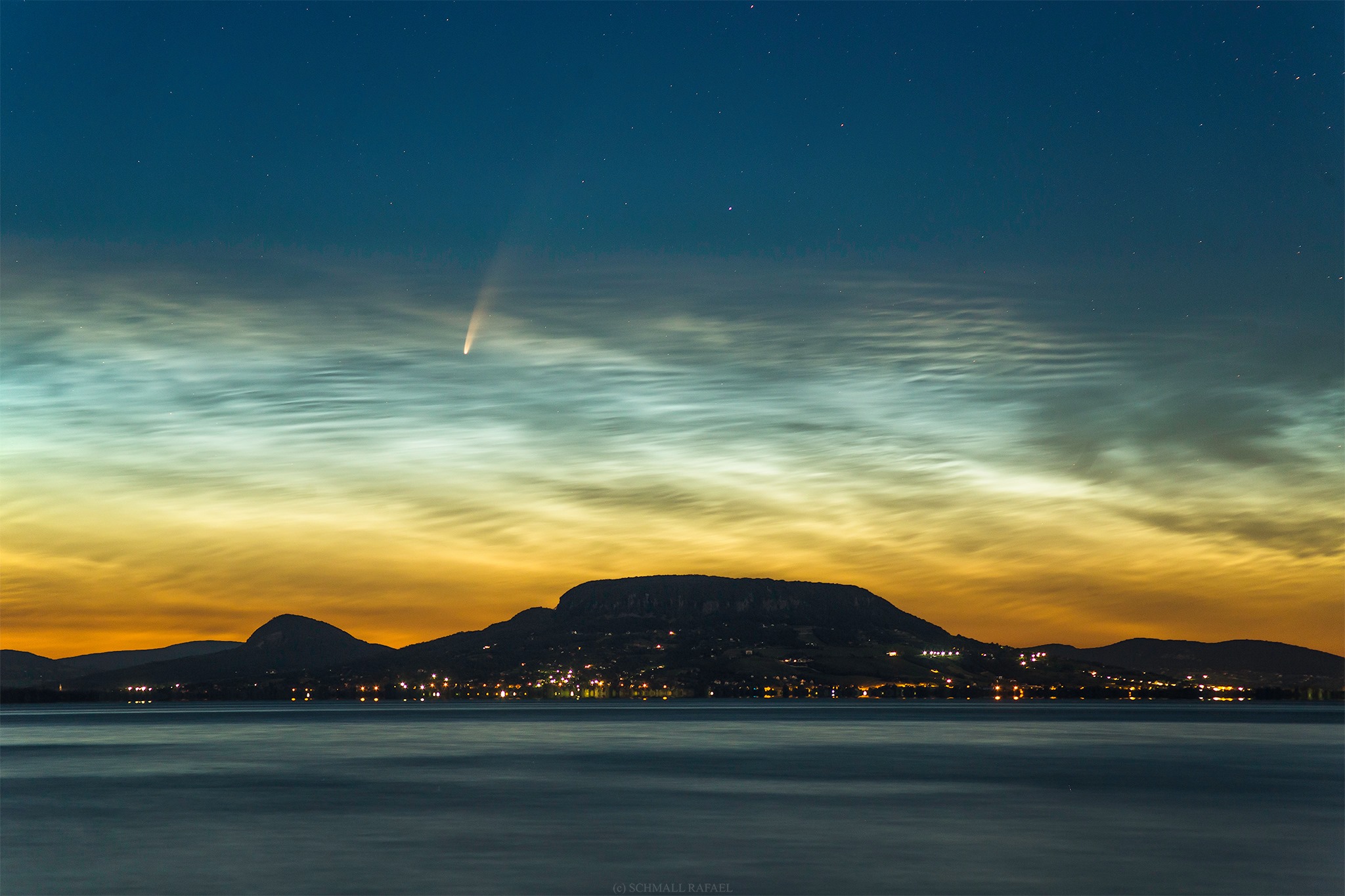
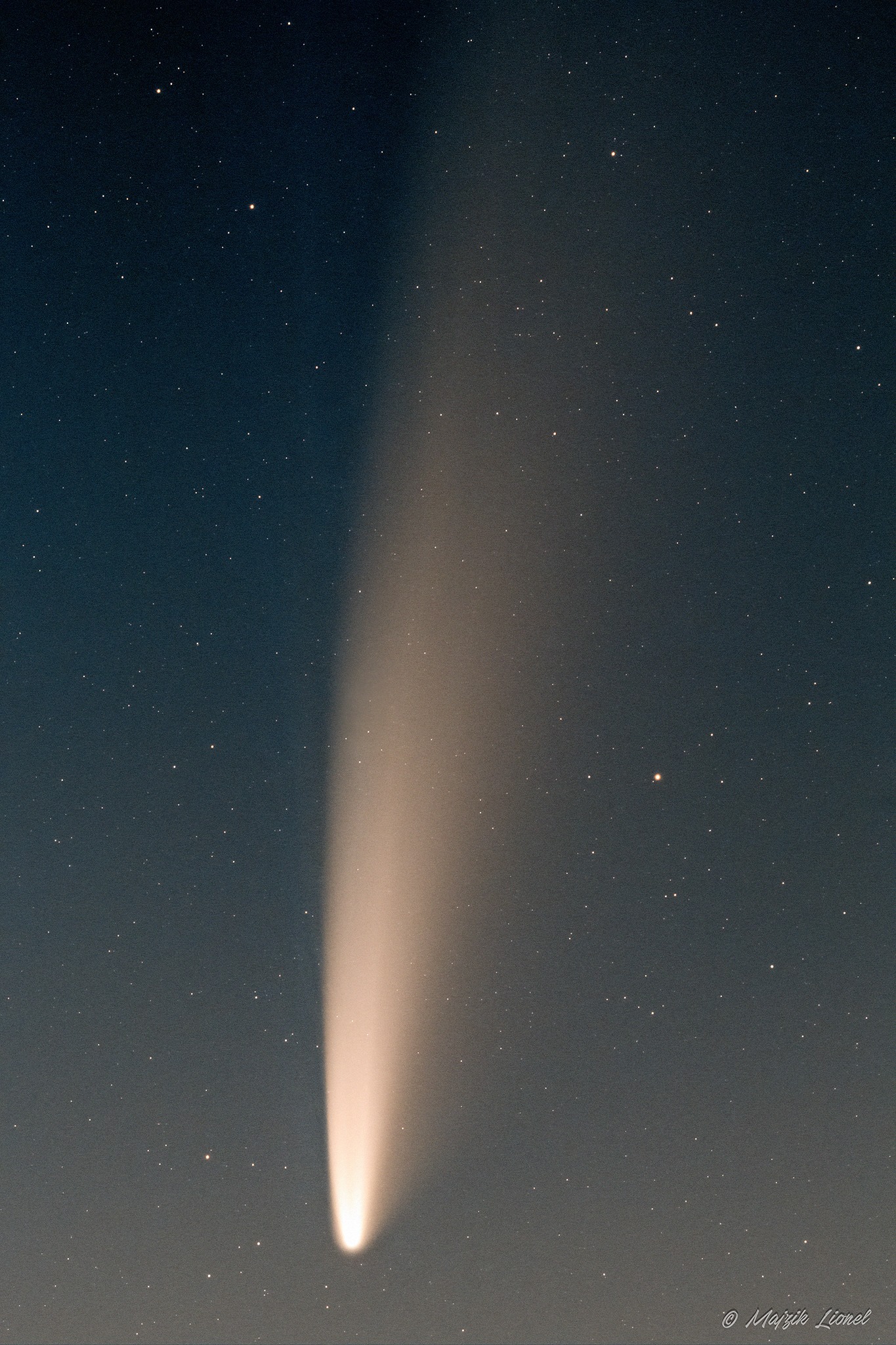
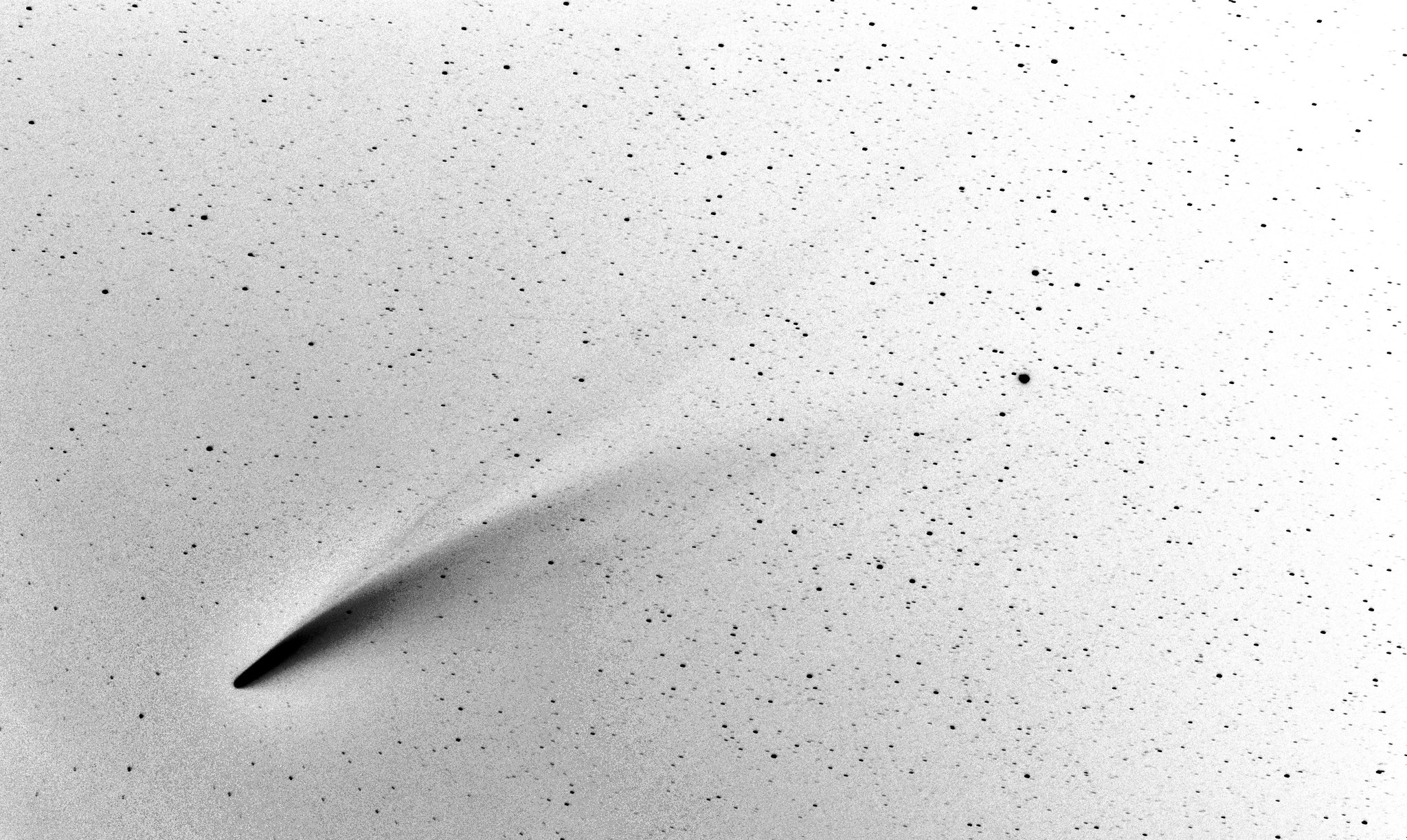
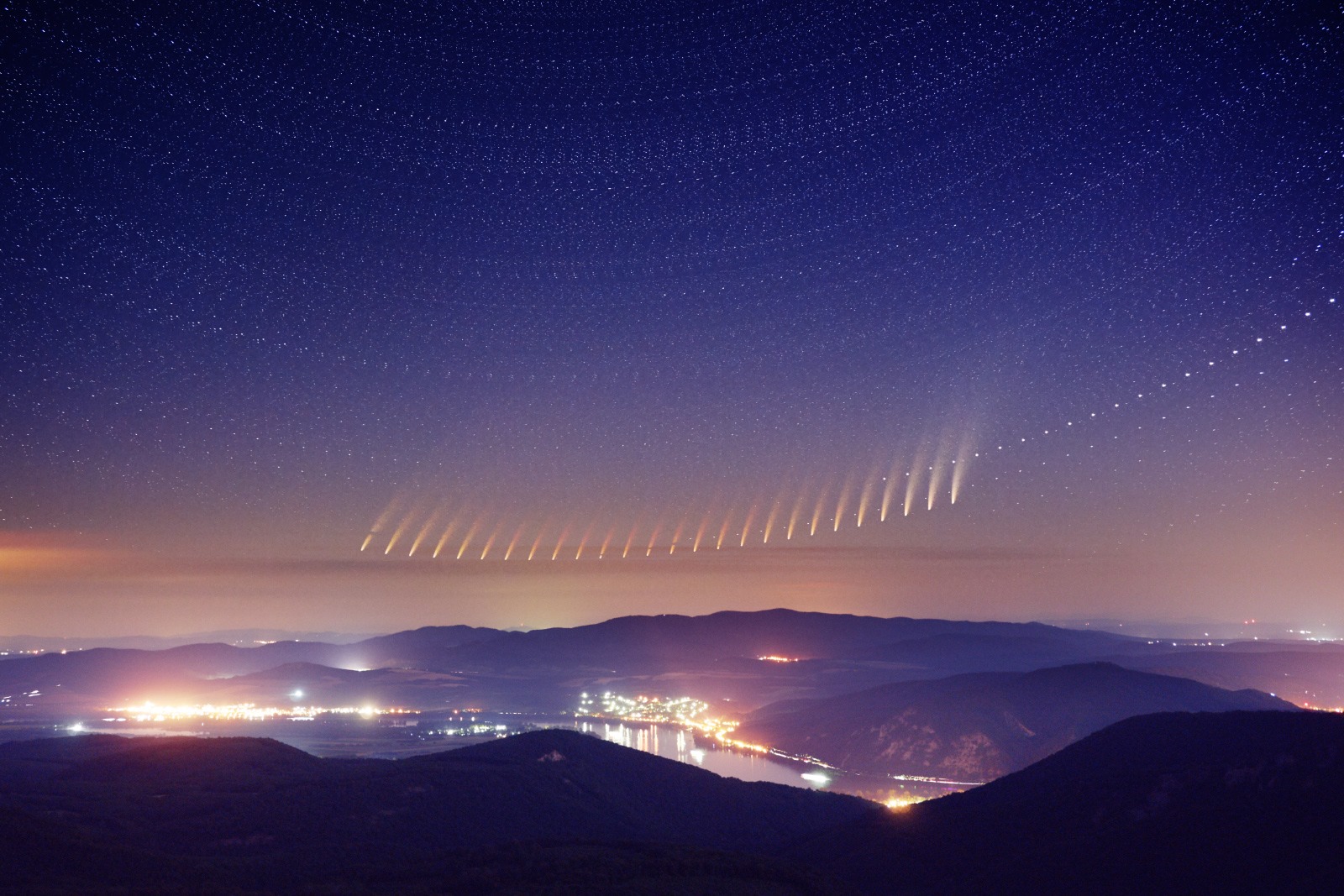
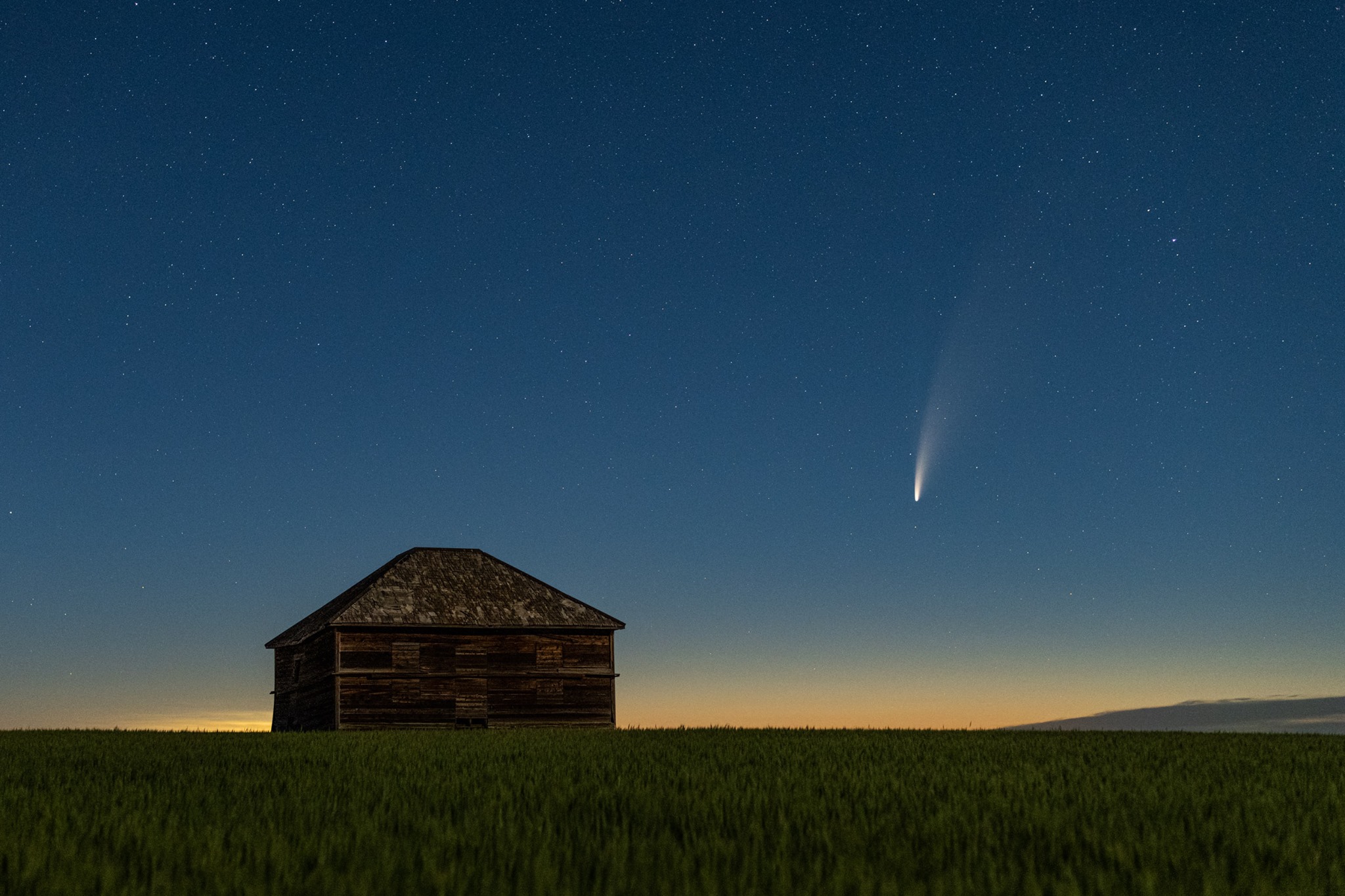
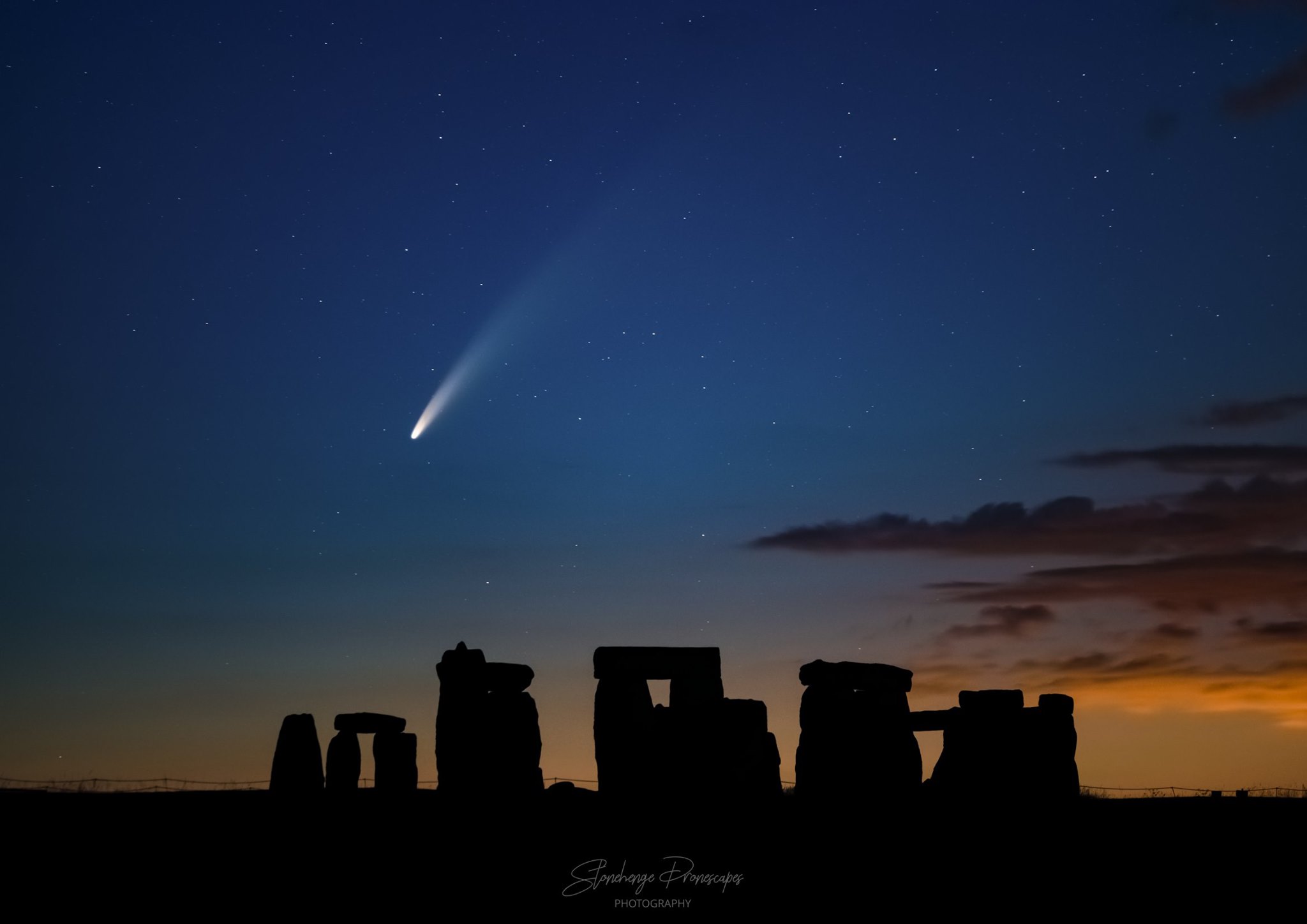
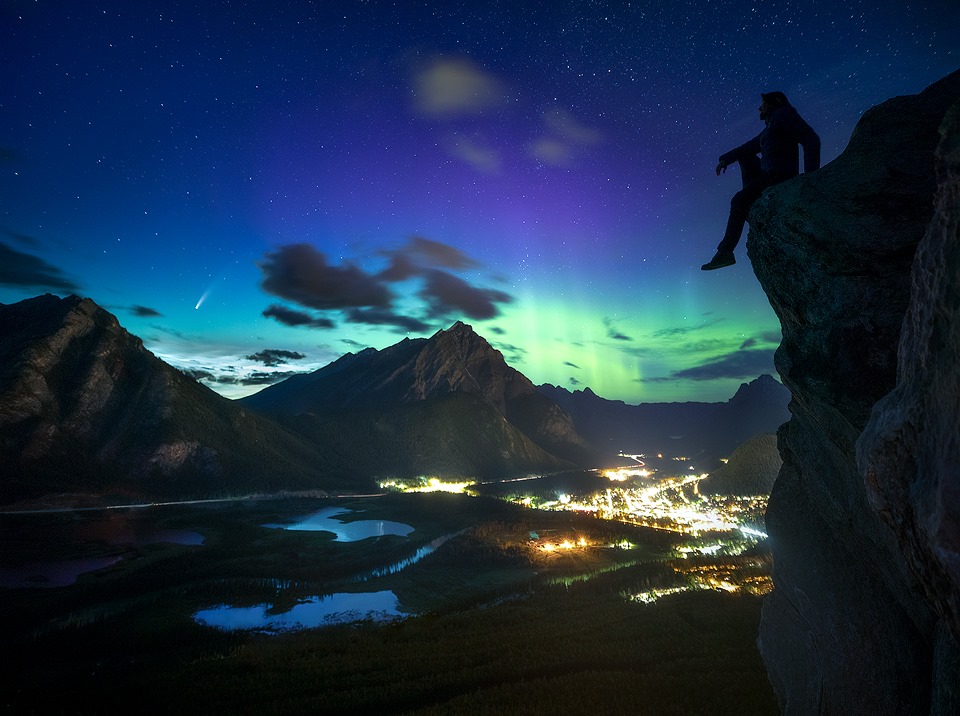
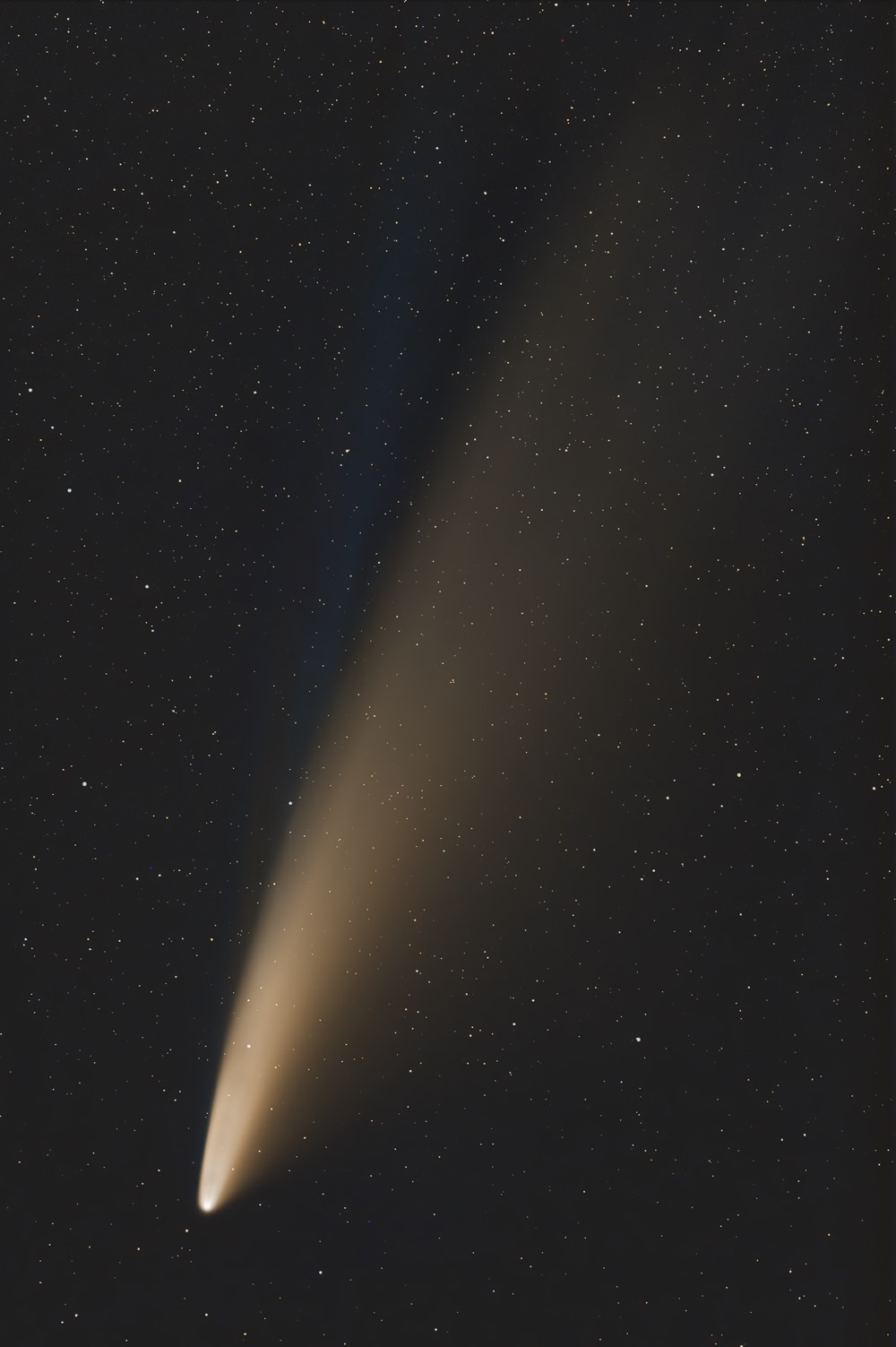
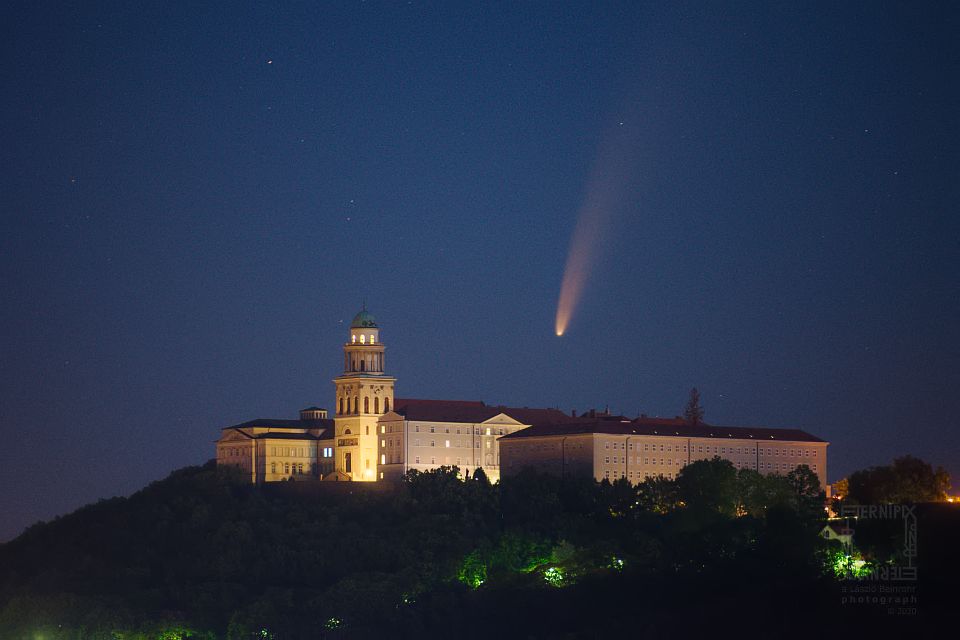
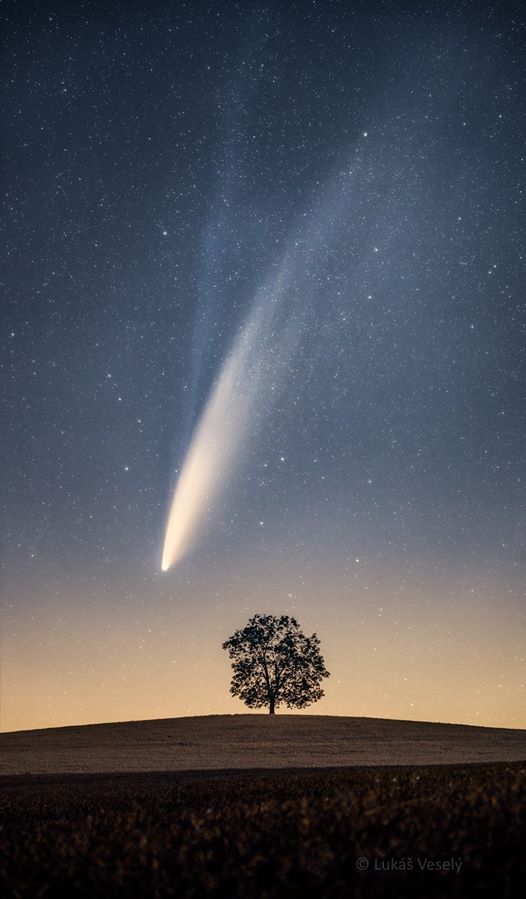
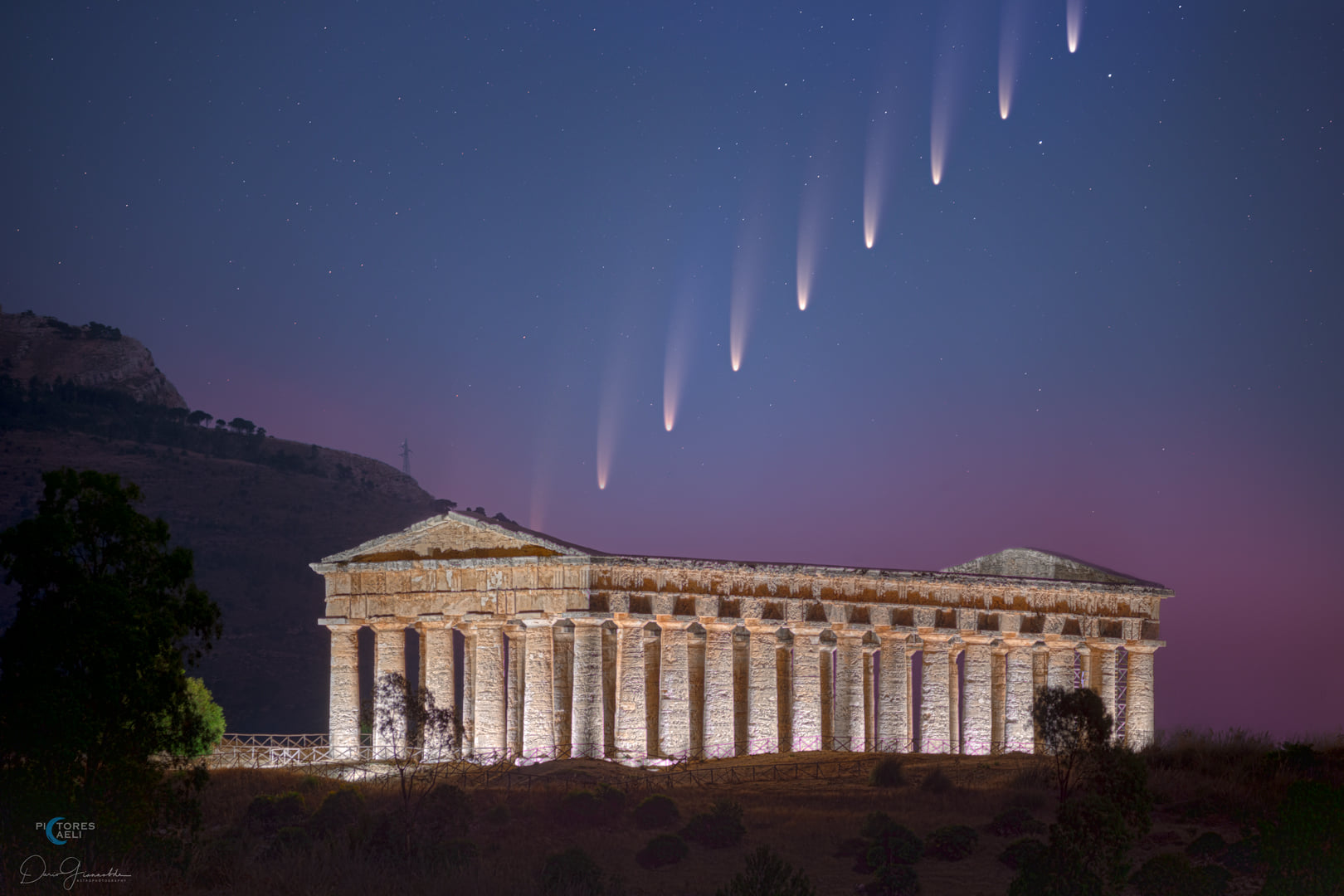

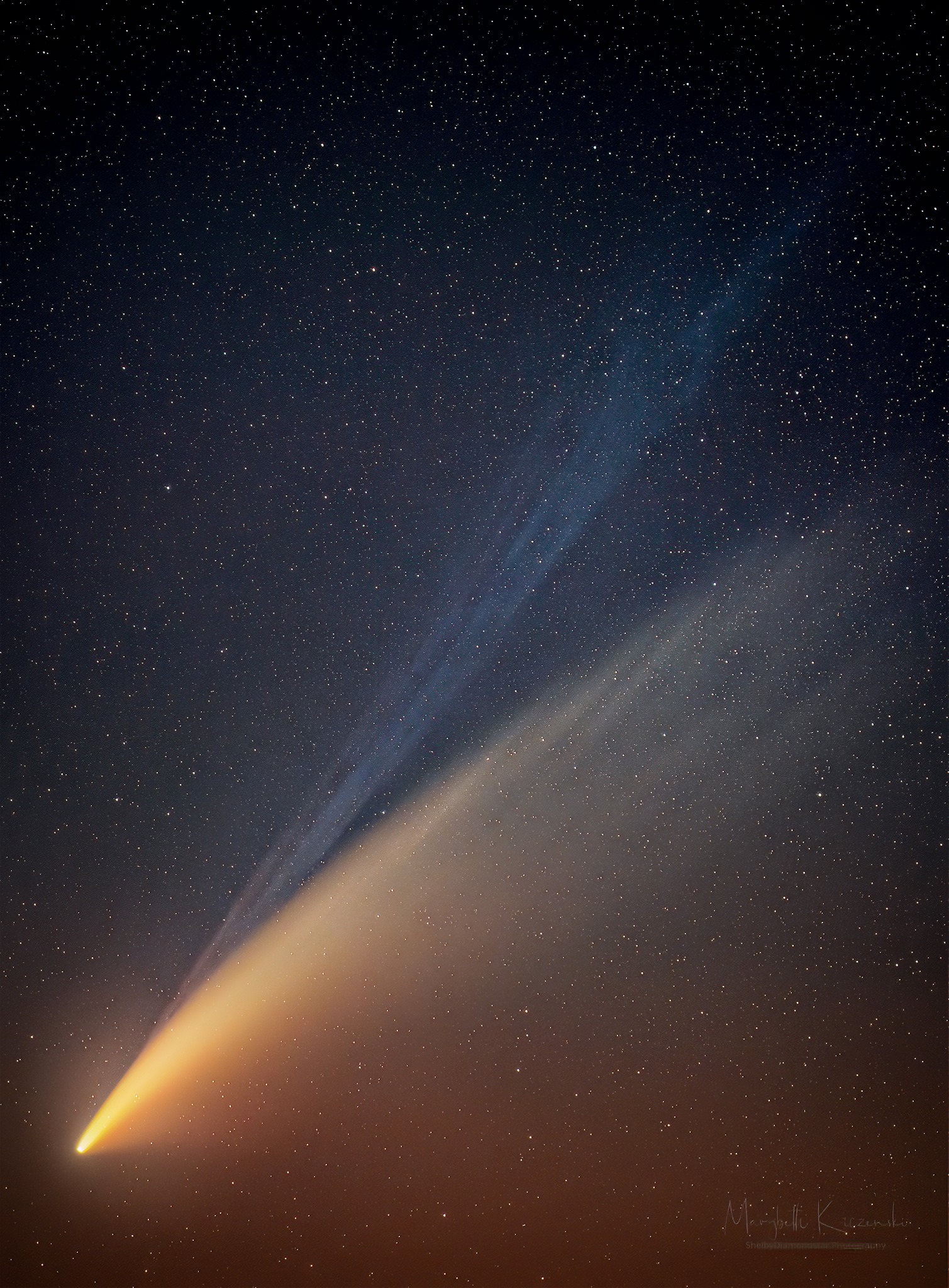
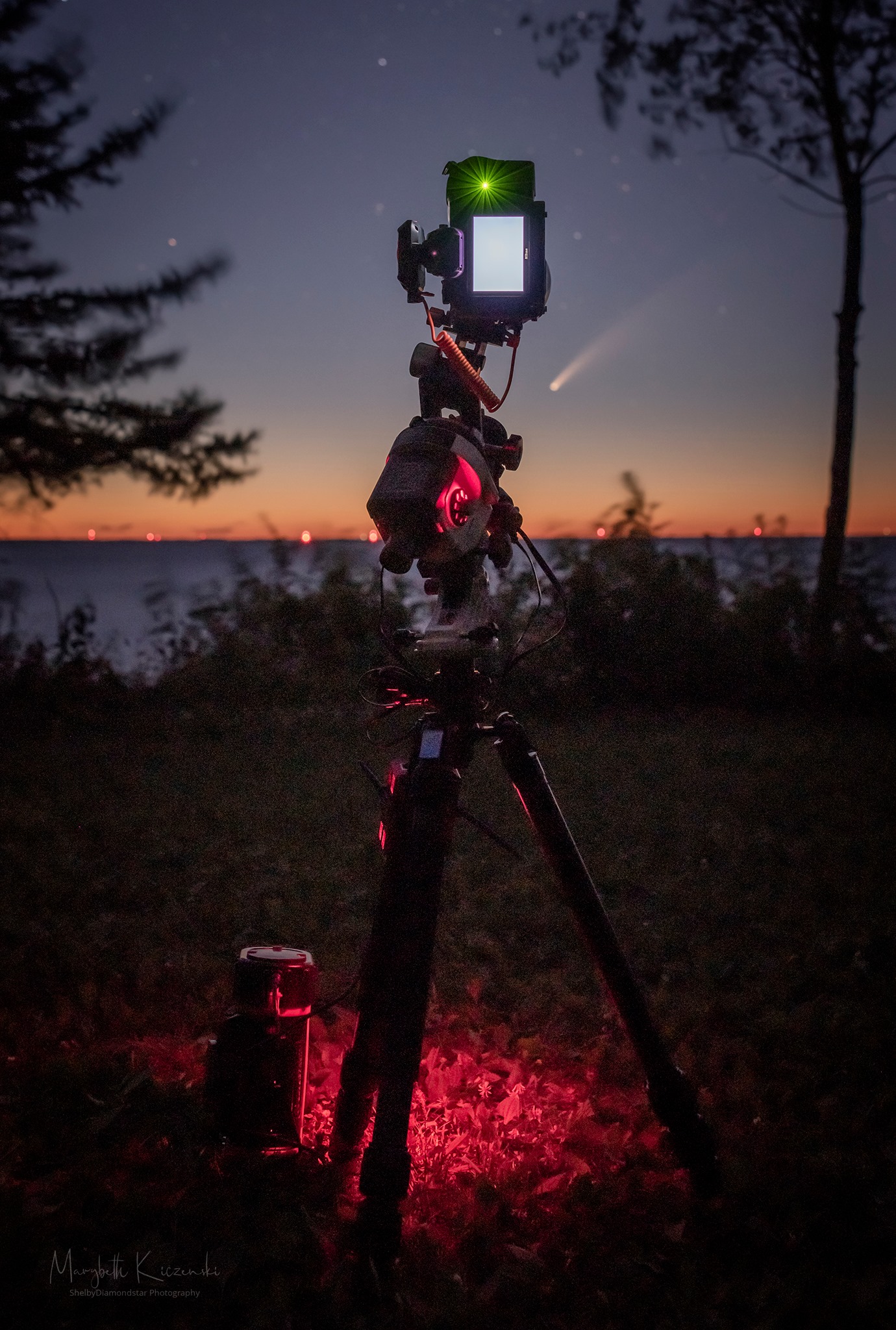
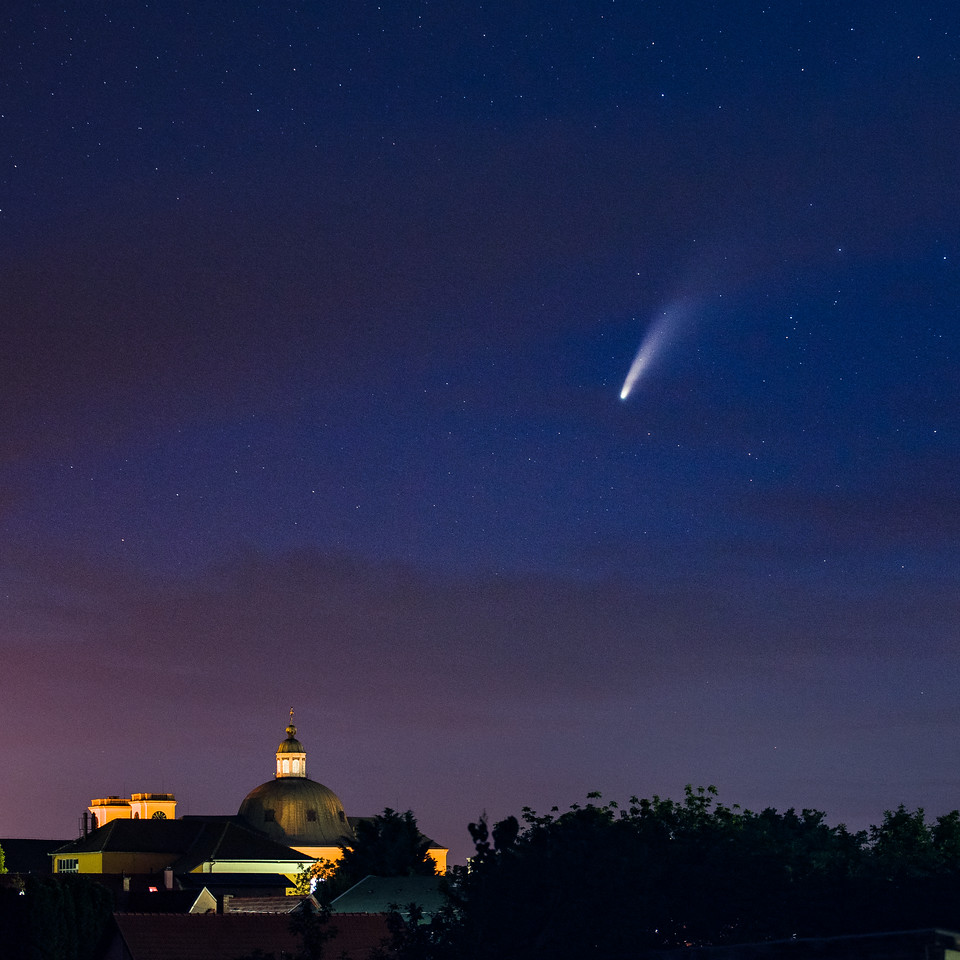
Seán Doran made an awesome video from the timelapse sequence taken from the several Nikon cameras on the International Space Station (ISS). Although it was recorded as a timelapse, Seán re-timed the video to make its speed real-life:
I took a photo from NASA (by the way, you too can get them here), and highlighted what can be seen:
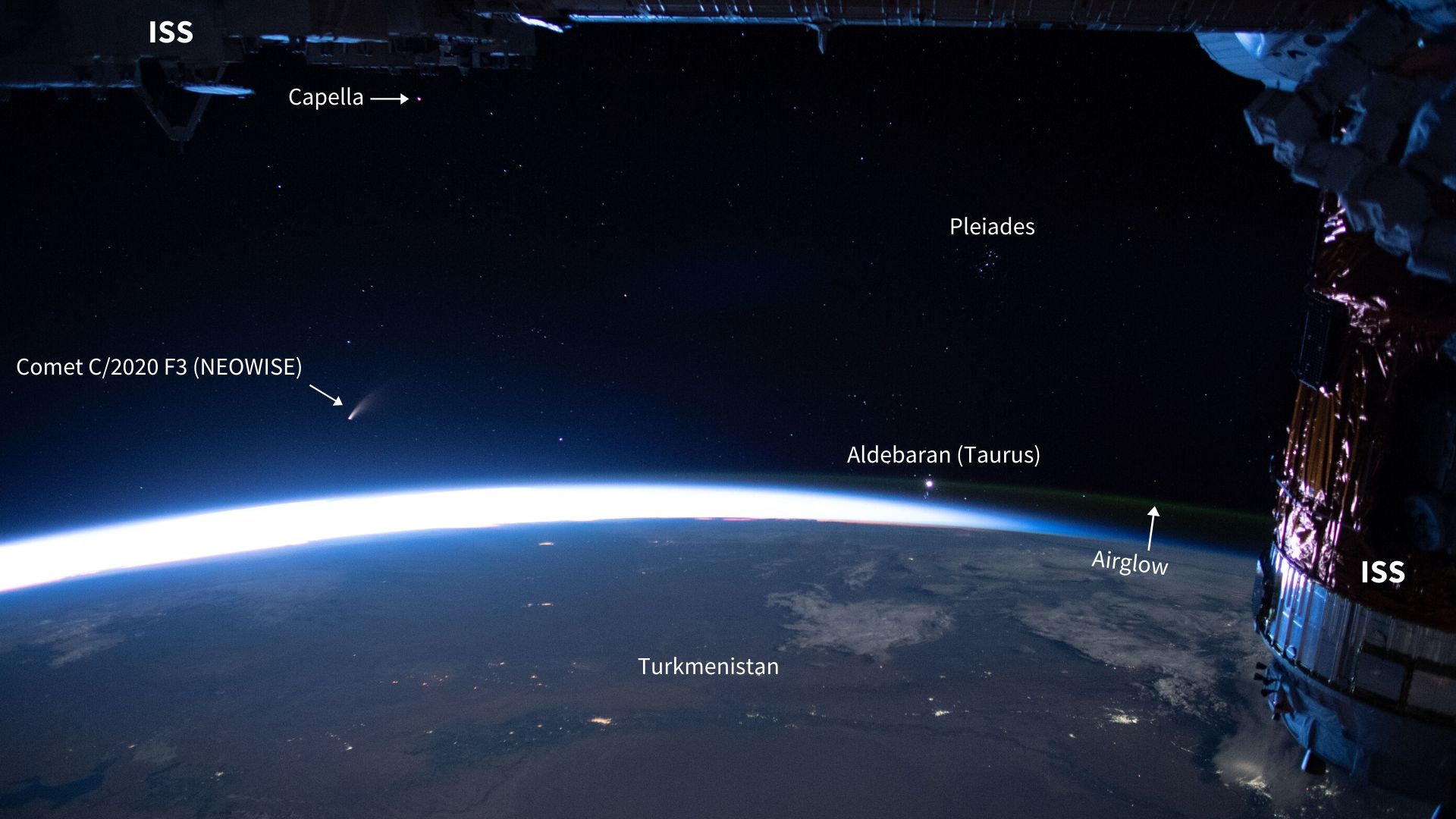
Interesting scientific facts behind C/2020 F3 (NEOWISE) comet
What is a dust and ion tail?
Comets typically have 3 visible parts:
- the nucleus – basically a loose icy-dust rock
- the coma – the very close area around the nucleus, it’s “atmosphere”
- the tail – evaporating gases / dust that the nucleus leaves behind
There are two kinds of tails: dust and ion tail.
Both tails are formed by the excessive heating power of the Sun. As the Sun is heating up the nucleus, gases star to evaporate and the comet starts to loose dust as well.
The dust tail simply follows the trajectory of the comet. These are literally dust particles that the comet leaves behind – later these become meteors.
The ion tail, however, is made up of mainly gases that are ionized by the solar wind, and follow the pattern of the magnetic field of the Sun.
Practically, the ion tail always points exactly away from the Sun (not always, see further below) .
On this magnificent photo by Michael Jäger, the ion tail is on the left, and the dust tail is on the right.
C/2020 F3 (Neowise) 2020 july 12 UT 21.30, mountain location, 3 panels Tele f-135/2.8 and CCD filter blue,
— Michael Jäger (@Komet123Jager) July 13, 2020
tail >20° large https://t.co/lOCLdVvutT
Michael Jäger pic.twitter.com/up4FsWs2q7
It’s also notable that the ion tail is always straight, but the dust tail always has some curvature.
Sometimes, if the angle of the comet, the Earth and Sun is such, the ion and dust tail can have totally different angles.
How long is the comet NEOWISE’s ion tail?
Krisztián Sárneczky, the head of “Comets” group of the Hungarian Astronomical Association published many super interesting posts on Facebook. With his permission I re-publish them in English here.
How long is the tail of comet NEOWISE?
With the ion tail, the answer seems very easy: that’s always pointing opposite of the Sun and is straight, so throwing in some trigonomical functions will get the result.
But, as always, it’s not that simple as it looks like.
Since th Hyakutake comet in 1996, we know that ion tails can be curved, and we knew previously that their direction does not always align with Sun – comet vector.
But even with the basic assumptions, we will get a rough estimate, using the follwing equation:
R*sin(L) / sin(phase-L)
Where R is the distance of the comet from Earth,
L is the apparent length of tail in degrees,
phase is the phase angle in degrees,
and will get the result in Astronomical Units (AU).
Based on the magnificent photo of the master Michael Jäger, taken on the evening of 12th July, we can estimate the ion tail to be 20 degrees long. As the comet was 0.84 AU from us, with a 103 degree phase angle, then we get 0.29 AU for the length of the ion tail, which means 45 million kilometers (if I’m correct).
This is almost the third of the Sun – Earth distance, and the Sun could easily put a leash on Mercury with that…
– Krisztián Sárneczky
Where does the name NEOWISE come from?
Again, Krisztián Sárneczky, comes to rescue:
So why is comet NEOWISE called NEOWISE?
As a guard of correct grammar of comets, I always correct people to write the comet’s name with all uppercase.
But why is the name all uppercase?
Because this comet was discovered by a satellite, and satellites tend to have very long names – therefore they are most often abbreviated into a mosaic word, which is supposed to be uppercase.
Moreover, this satellite even changed its name.
That’s how it’s original name, WISE (Wide-field Infrared Survey Explorer), became
Near-Earth Object WISE, or NEOWISE.
Speaking of official names of comets, the all uppercase is kept! And if we write the C/2020 F3 as well, then we have to put NEOWISE within brackets.
Unfortunately, nowadays there are less and less comets discovered by humans (eg. Halley, Bradfield or Lovejoy), so all uppercase names are on the rise.
So unless there’s a guy called John Neowise or Jesús Atlas who happens to discover a comet, we have to write NEOWISE.
Attached is the composite photo from 27th March from NASA. The red dots are the comet NEOWISE at 15 magnitude brightness, taken at 90 minutes intervals.
– Krisztián Sárneczky
So basically, we should write either C/2020 F3 (NEOWISE), or comet NEOWISE.
Useful links
Taking photos of stars and Milky Way (my article)
Sky & Telescope’s article on comet NEOWISE
Space.com’s article on comet NEOWISE
The Art of Night Photography group on Facebook (many photographers post here first)
Precise finding charts and ephemerids
Wikipedia’s article on comets (some must see photos there)
Photos on cover image by Miklós Mayer and Marybeth Kiczenski, composited together by Miklós Mayer.

 Welcome! I'm Miklós Mayer, a photo tour guide in Hungary. My job is to show fellow photographers around in my home city and teach them everything I know about photography.
Welcome! I'm Miklós Mayer, a photo tour guide in Hungary. My job is to show fellow photographers around in my home city and teach them everything I know about photography.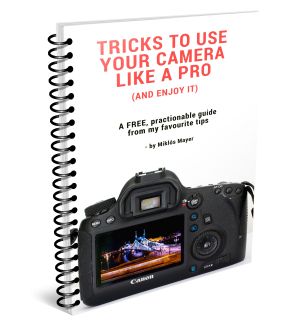
Leave a Reply